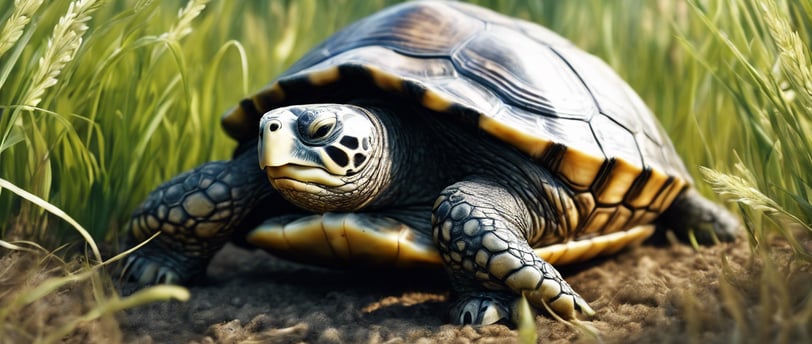What Size Tank Does a Turtle Need?
Tank Size Recommendations by Turtle Specie


Choosing the right tank size for your turtle is one of the most important decisions you’ll make as a pet owner. Turtles are active creatures that need plenty of space to swim, bask, and explore. Providing a proper habitat not only ensures their health and happiness but also makes maintenance easier for you. Let’s dive into the details of how to select the ideal tank size for your shelled companion.
How Big Should a Turtle Tank Be?
A general rule of thumb is to provide 10 gallons of tank space per inch of your turtle’s shell length. This formula ensures the tank is spacious enough for swimming and other natural behaviors. For example:
A 4-inch turtle needs a 40-gallon tank.
A 6-inch turtle requires a 60-gallon tank.
Larger turtles, like a red-eared slider reaching 12 inches, need tanks of 120 gallons or more.
Why Tank Size Matters for Turtles
Turtles are semi-aquatic animals, meaning they spend time both swimming in water and basking on land. A small tank can lead to:
Stress and inactivity: Turtles need space to swim and explore.
Poor water quality: Smaller tanks accumulate waste faster, requiring more frequent cleaning.
Health problems: A cramped environment can cause shell deformities and other health issues.
Providing a tank that meets or exceeds the minimum size ensures your turtle can live a long, healthy life.
Tank Size Recommendations by Turtle Species
Here are some specific recommendations based on common pet turtle species:
Red-Eared Slider
Adult size: 8–12 inches
Minimum tank size: 75–120 gallons
These active swimmers need deep water and ample basking space.
https://reptifiles.com/red-eared-slider-care/red-eared-slider-tank-size/
Painted Turtle
Adult size: 6–8 inches
Minimum tank size: 55–80 gallons
Painted turtles enjoy a combination of shallow and deep water areas.
Musk Turtle
Adult size: 3–5 inches
Minimum tank size: 30–40 gallons
Musk turtles are less active and prefer shallow water.
Map Turtle
Adult size: 5–10 inches
Minimum tank size: 50–90 gallons
These turtles are avid swimmers and need a larger space.
Why Bigger is Always Better for Turtle Tanks
Although the recommendations above are minimum guidelines, providing a larger tank has many benefits:
Better water quality: Larger tanks dilute waste, making it easier to maintain clean water.
Room for growth: Turtles grow over time, and a larger tank eliminates the need for frequent upgrades.
Enrichment opportunities: More space allows you to add plants, rocks, and other decorations to mimic their natural environment.
Other Tank Setup Considerations
When choosing a tank, size isn’t the only factor. Here are a few other essentials for a healthy turtle enclosure:
Water Depth
The water should be deep enough for swimming—at least 2–3 times the turtle's shell length.
Basking Area
Include a dry area where your turtle can bask under a UVB lamp. Basking is essential for regulating body temperature and preventing shell diseases.
Filtration System
A high-quality filter is crucial to keep the water clean and safe. Turtles produce a lot of waste, so invest in a filter designed for tanks larger than the actual size.
Tank Material
Glass aquariums are the most popular, but plastic or acrylic tanks can also work for smaller turtles. For larger species, custom-built enclosures might be necessary.
Tank Lid
Use a secure lid to prevent your turtle from escaping and to protect them from other pets or falling objects.
Mistakes to Avoid When Choosing a Turtle Tank
Starting too small: Always plan for your turtle’s adult size. A small tank will quickly become inadequate as your turtle grows.
Ignoring water depth: Turtles need enough space to swim comfortably, not just shallow water.
Overcrowding the tank: Adding too many decorations or keeping multiple turtles in a small tank can limit swimming space.
FAQs About Turtle Tank Size
Q: Can I use a fish tank for my turtle?
A: Yes, many fish tanks are suitable for turtles as long as they meet the size and depth requirements. Add a basking platform and UVB lighting to make it turtle-friendly.
Q: How often do I need to upgrade my turtle’s tank?
A: Ideally, start with a tank that matches the turtle's adult size. If your turtle grows larger than expected, upgrade accordingly.
Q: Do baby turtles need smaller tanks?
A: While baby turtles can survive in smaller tanks, it’s better to provide a larger tank from the start. This reduces stress and saves money on upgrades.
Conclusion: Choosing the Best Tank for Your Turtle
The right tank size is essential for your turtle’s health and happiness. Always prioritize their needs by providing enough swimming space, a basking area, and clean water. Remember, a bigger tank is always better! For more tips on setting up a turtle enclosure, explore sreptile.com.
